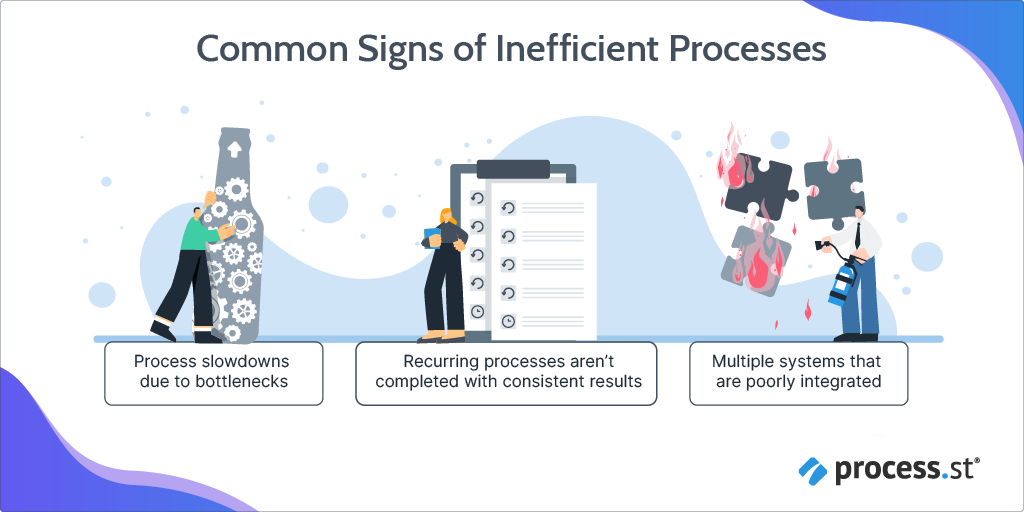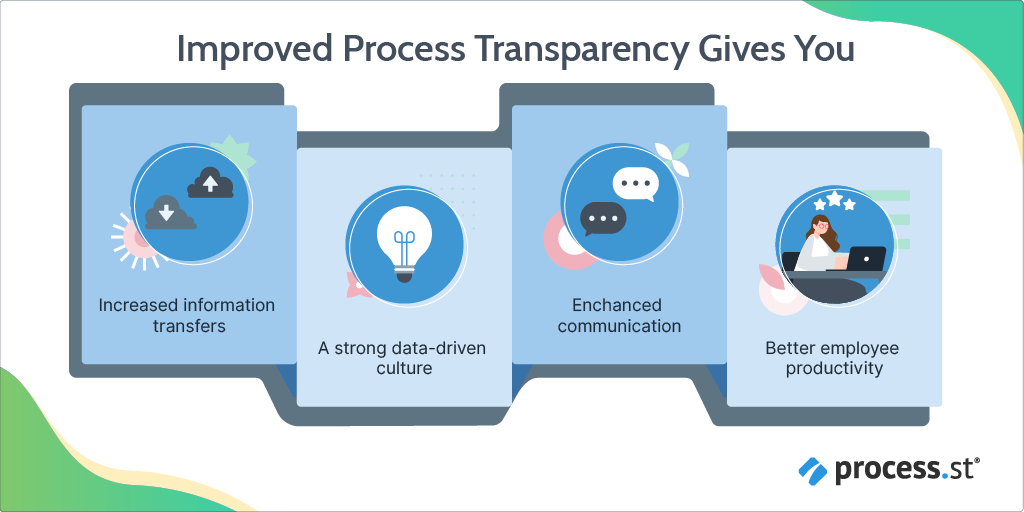
86% of executives and employees believe a lack of collaboration is the main reason behind company failure. From this, it’s easy to see how an entire company feels more connected when everyone is working with the same vision and information.
That’s what makes process transparency so crucial to organizational success. Studies show that organizations with more transparent processes help enhance collaboration, increase engagement, and improve productivity.
Along with this, employees also believe workplace transparency to be a large contributing factor to job satisfaction.
So, if your company lacks process visibility, you’re not providing transparency in the workplace and run the risk of losing valuable employees.
- Why is process transparency important?
- What are the common signs your processes lack transparency?
- What happens when process visibility is poor?
- What do you get from good business process transparency?
- Investing in the right tools makes everything more transparent
Why is process transparency important?
Process transparency is vital for the success of a company. Every business owner knows that without processes, there isn’t any business.
When these processes are inefficient and lack transparency, employees aren’t getting the right information to do their work, which leads to:
- Poor forecasting abilities
- A lack of direction and responsibility
- Fragmented and inconsistent processes
As a result, companies run a massive risk of making errors, losing money, wasting effort, and alienating vendors or customers.
However, when your company is equipped with transparent processes, you can easily
- Make informed decisions
- Track what is being done within a process
- Measure team performance and process efficiency
- Gain insight into employee, team, and overall company productivity
What are common signs your processes lack transparency?
Let’s face it, you’ve got a lot of work to do in a day.
You’re not hyperfocused and taking notes on how your processes are running because the processes are running and the work is being done. As far as you know, you’ve got some decent processes in place.
The sneaky thing about process transparency is that you don’t know it’s a problem until it’s a BIG problem.
However, there are some indications to help you get ahead of the game before all your processes come crashing down.

Bottlenecks are slowing down your processes
Slowdowns in your processes have a significant impact on your bottom line. You might have many obstacles in the way that prevent your team from efficiently performing these processes.
One example might be someone who has control over the process and isn’t running it during the right intervals. Otherwise, you might not be employing the right technology to ensure these processes run smoothly.
In most instances, businesses overlook these bottlenecks because the lack of transparency makes identifying them more challenging.
The process continues as normal because nobody fully understands the impact these bottlenecks have on the overall performance.
What’s the solution?
A good way to identify bottlenecks is to use the “5 Whys Technique,” which goes like this:
Let’s consider a process the marketing department uses each time they publish an advertisement.
- Problem: The marketing advertisement was delayed
- Why? The coding needed by the development team wasn’t ready in time
- Why? The developers doing the coding already had a full workload
- Why? They had an increase in the number of projects they were responsible for
- Why? This typically happens during this time of the year
- Why? No prioritization or planning is made for seasonal variations in workloads
With the 5 Whys Technique, you’re working backward and asking why for each issue you encountered until you find the root cause for the bottleneck. You then have a starting point to resolve this issue.
You have redundancies or duplications in your process
Are your employees spending time doing duplicate tasks? This can typically occur when departments work in silos.
There’s a lack of communication between employees during cross-departmental collaboration so different departments are doing the same tasks within a shared process.
Otherwise, you might have tedious tasks making up your process that can be easily automated. However, instead of implementing these automations to remove redundant tasks, your employees continue to do the work. An example of this might be data entry.
Tons of reasons exist for why this might occur. Nonetheless, you’re slowing the process, losing profits, and wasting time.
How can you fix it?
First, you want to look at the processes that require cross-departmental collaboration. From here, you can identify what tasks each department is responsible for.
With Process Street, the Groups feature allows you to assign a specific department or team to the task.
Next, you should take a look at this official process and audit it to see where tasks could be automated.
One example might be sending an email. With Process Street, you can embed the email widget into a task. Here you have a pre-written email with variable information (like the new hire’s name, start date, and email address).
Once you run the process, you can automatically send out the email that includes specific information pulled from data already collected early on in the process.
There are variations in your processes
You need to have a common agreed-upon process to ensure you’re getting the same, consistent results each time a process is run.
In many instances, these different processes might be used to achieve the same result. Or else, there’s a lack of documentation or training to tell your employees the right way to complete these processes.
Whatever it might be, this could be the reason your team is producing different results. Your goal should always be to run consistent processes that deliver the same expected result each time.
How do you solve it?
For each activity that requires a process, you need to look at how many of these processes exist and remove them until only one official process is available.
For example, you onboard a new employee. You want to have only one onboarding process for this new hire to follow. If you have many variations of this process already, you’ll get inconsistent results for each employee you onboard.
Your goal should be to create one official onboarding process that is the only one used when a new hire is welcomed into a company.
You’ve poorly integrated multiple systems
You’re bound to have disparate information sources if your business has various standalone applications and systems that are poorly integrated. As a result, your team will spend wasted hours manually entering data from one application to the other.
Employee churn and productivity issues are two expected outcomes of these poorly-integrated systems.
What can you do to fix it?
Process Street’s Automations allows you to pass data to and from other apps. These integrations can be done with more than 2,000 applications. This reduces the amount of manual copy-pasting your team needs to do.
What happens when process visibility is poor?
Now that you can identify poor process transparency, it’s important to understand how this can wreak havoc on your company:
Delays in reporting
Many companies use their quarterly, monthly, or weekly reports to guide them through their decision-making. Before these reports can be looked through, small issues have already snowballed into far more problematic ones.
For example, a banking professional who only checks their reports every 30 days is likely to miss noticing and identifying a steep drop in new customers.
They’d only notice once they receive this monthly report. By then, the damage has already been done, and finding the problem and rectifying it would be ineffective.
This wouldn’t be the case if the banking professional had a real-time reporting link to a process management tool that would flag the potential issue. Having this real-time transparency would ensure the professional could intervene before more new customers left.
Inaccurate KPIs and goals
Big data has made it difficult not to fall down the data rabbit hole. All this access to information is just as bad as not having enough. Of course, analytics can help quieten the noise.
However, your monitoring strategy needs to be related to specific goals to pick out valuable data from the noise. If this strategy isn’t implemented, you’ll only have tools collecting information that means nothing because it can’t be put into context.
No or very few automation capabilities
An ineffective process will slow down your productivity and can rapidly drain your revenue. When you have clear transparency over your processes, you can easily see any gaps where you’re losing money on inefficiency.
One of the most unproductive parts of a process is analog tasks. When you have transparency over what needs to be done in a process, you can identify recurring and tedious tasks. Automations can then be used to remove any human input and save your employees time.
However, without this transparency, you can see where these automation opportunities are, leaving you vulnerable to revenue drains all across your organizational processes.
Resources are improperly allocated
Accurate insights into process performance help managers with decision-making. From historical trends shown in these insights, managers can decide where resources should be distributed for maximized optimization.
With process transparency, these insights can’t be based on accurate information. That means managers won’t be making the best decisions when allocating resources.
Employee training time is increased
Onboarding is one of the most important elements of welcoming a new employee into an organization. The way you conduct onboarding activities will increase or decrease your employee churn.
One element of onboarding is employee training. Having a good employee training program in place helps get these new hires working more efficiently, and faster.
However, if there isn’t any transparency in your training processes, your new hires can quickly be left without any clear direction and end up confused and unmotivated.
It takes them longer to start working independently, which means you’re missing out on unlocking your new hire’s full productivity.
What do you get from good business process transparency?

Better communication
Communication through an entire organization is difficult to get right. But if you have all the data you need to communicate across a software delivery pipeline, it can help make everything transparent and accessible to everyone.
Faster information transfer
Documenting your processes through workflow management software can create a centralized knowledge base for your entire company. This makes all company information transparent and available to everyone. You no longer need to search through endless files in various locations to find the information you need to complete your work.
Enhanced engagement and productivity
When your processes are more transparent, the work your employees do becomes easier and more meaningful. You have better guidance over what work you need to do and you can clearly see how this work adds meaning to the entire organization.
These two elements have astronomical benefits for your workforce because your employees are motivated to do the work. This pushes productivity and engagement.
Accurate data-driven decision-making
Transparent processes provide more accurate data. When it comes time to make decisions based on past trends, these analytics provide better insight, and resources can be allocated more effectively.
Investing in the right tools makes everything more transparent
As companies scale, it can be more challenging to keep tabs on the inner workings of each department. Before you know it, there’s no clear idea of what goes where, who knows what, and how did this get there.
The solution? Digital workflow management is what you need to have clear transparency over your processes. It’s what’s going to help you identify:
- Bottlenecks in your processes
- Drains where your resources are falling into
- Areas that can be automated
With proper documentation, you create a centralized hub for all your organizational processes. Everyone has access to it. The processes can be updated in real-time. And your analytics are based on data taken from these processes.
Do you suffer from a lack of process transparency? How does it affect your performance? Let us know in the comments below.







 Workflows
Workflows Forms
Forms Data Sets
Data Sets Pages
Pages Process AI
Process AI Automations
Automations Analytics
Analytics Apps
Apps Integrations
Integrations
 Property management
Property management
 Human resources
Human resources
 Customer management
Customer management
 Information technology
Information technology



Grace Donaldson
Grace is a content writer with a thirst for knowledge and coffee. You'll find her reading in a small café or singing at a rundown jazz bar when she's not overconsuming coffee or compartmentalizing her thoughts into a blog post.